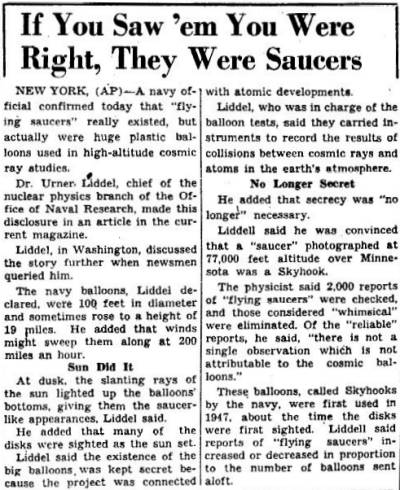This article was published in the daily newspaper The Evening Telegraph, of Dixon, Illinois, USA, on February 13, 1951.

|
NEW YORK, (AP) -- A navy official confirmed today that "flying saucers" really existed, but actually were huge plastic balloons used in high altitude cosmic ray studies.
Dr. Urner Liddel, chief of the nuclear physics branch of the Office of Naval Research, made this disclosure in an article in the current magazine.
Liddel, in Washington, discussed the story further when newsmen queried him.
The Navy balloons, Liddel declared, were 100 feet in diameter and sometimes rose to a height of 19 miles. He added that winds might sweep them along at 200 miles an hour.
Sun did it
At dusk, the slanting rays of the sun lighted up the balloons' bottoms, giving them the saucer like appearances, Liddel said.
He added that many of the disks were sighted as the sun set. Liddel said the existence of the big balloons was kept secret because the project was connected with atomic developments.
Liddel, who was in charge of the balloons tests, said they carried instruments to record the results of collisions between cosmic rays and atoms in the earth's atmosphere.
No Longer Secret
He added that secrecy was "no longer necessary."
Liddel said he was convinced that a "saucer" photographed at 77.000 feet altitude over Minnesota was a Skyhook.
The physicist said 2.000 reports of "flying saucers" were checked, and those considered "whimsical" were eliminated. Of the "reliable" reports, he said, "there is not a single observation which is not attributable to the cosmic balloons."
These balloons, called Skyhooks by the Navy, were first used in 1947, about the time the disk were first sighted. Liddell said reports of "flying saucers" increased or decreased in proportion to the number of balloons sent aloft.